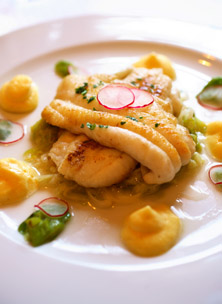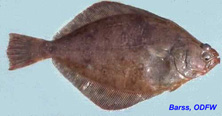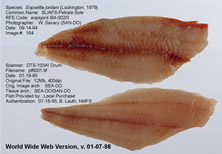Petrale Sole (Eopsetta jordani)
- Off the West Coast, petrale sole population levels are rising.
- Petrale sole is managed using a coastwide Acceptable Biological Catch, a scientific calculation of the sustainable harvest level of a fishery used to set total allowable catch limits.
- Petrale sole is an excellent source of low-fat protein, calcium, and other important nutrients. For more on nutrition, see Nutrition Facts. (USDA)
- Petrale sole is an important commercial seafood species due to its size and flavorful meat.
|
 |
 |
 |
 |
| Nutrition Facts |
| Servings 1 |
| Serving Weight
100g |
 |
| Amount Per Serving |
 |
| Calories 91 |
 |
| Total Fat |
1.19 g |
 |
| Total Saturated Fatty Acids |
0.283 g |
 |
| Carbohydrate |
0 g |
| Sugars |
0 g |
| Total Dietary
Fiber |
0 g |
 |
| Cholesterol |
48 mg |
 |
| Selenium |
32.7 mcg |
 |
| Sodium |
81 mg |
 |
| Protein |
18.84 g |
 |
|
 |
 Deploying a bottom trawl net from the NOAA research vessel Miller Freeman. Researchers are studying the effects of trawls (the primary gear used to catch Petrale sole) on the ocean floor using a camera system towed over an area by the ship. Deploying a bottom trawl net from the NOAA research vessel Miller Freeman. Researchers are studying the effects of trawls (the primary gear used to catch Petrale sole) on the ocean floor using a camera system towed over an area by the ship.
|
 |
Did you know?
Landings of petrale sole off Oregon are second only to those of Dover sole among the flatfish, and they bring the highest price per pound among the trawl caught flatfish.
Petrale sole are not a popular recreational species because they are found at such great depths.
Adult petrale sole are cannibalistic, sometimes eating large amounts of juveniles.
|
|
| |
 |
|
Petrale sole is a right-eyed flounder (both eyes are on its right side), with an oval to round body. Its eyed side is uniform light to dark brown, and its blind side is white, sometimes with pink traces.
|
 |
|
Petrale sole is an important foodfish because of its excellent quality and taste. Like all flatfish, the fillets (above) are thin.
|
|
Sustainability Status
Biomass: West Coast biomass is 80% of the biomass needed to support maximum sustainable yield.
Overfishing: No
Overfished: No
Fishing and habitat: Bottom trawls are used to catch Petrale sole on soft bottoms off the Pacific coast. Because the species inhabiting soft bottom communities are frequently fast growing and short-lived, these communities may be more resilient to trawling impacts than other habitats.
Bycatch: Bycatch depends on the location and depth of fishing operations; in this fishery, there is a higher rate of bycatch in the north and in shallow water. Area closures, reduced trip limits, and non-retention rules have been imposed to reduce bycatch of overfished rockfish. Gear restrictions to reduce bycatch include minimum trawl mesh sizes, small footrope regulations, and the mandatory use of selective flatfish trawls in the north. Variable catch limits are used to encourage fishing with gears and in areas with less bycatch.
Aquaculture: There is currently no commercial aquaculture of petrale sole in the United States, but the species has been considered to have great potential for commercial aquaculture.
|
Science and Management
Petrale sole is managed by the Pacific Fishery Management Council through the Pacific Coast Groundfish Fishery Management Plan (FMP). Petrale sole is managed using a coastwide Acceptable Biological Catch (ABC). The ABC is an estimation of the sustainable harvest level of a fishery and is used to set total allowable catch limits. Area closures are also used for groundfish management. In 1994, Amendment 6 to the Groundfish FMP set up a limited entry program for the groundfish fishery. In 2003, NOAA's National Marine Fisheries Service (NMFS) implemented a vessel buyback program to reduce the number of vessels and permits in the Pacific coast groundfish trawl fishery in order to limit fishing effort, increase productivity in the fishery, financially stabilize the fishery, and conserve and manage the groundfish resource.
In Alaska, petrale sole are included in the Gulf of Alaska Groundfish FMP as part of the shallow water flatfish complex and in the Bering Sea Aleutian Islands Groundfish FMP as part of the other flatfish complex. There is no directed fishery for this species in Alaska, and only minor amounts are landed in other fisheries.
|
Life History and Habitat
Life history, including information on the habitat, growth, feeding, and reproduction of a species, is important because it affects how a fishery is managed.
- Geographic range: Petrale sole are found from Cape St. Elias, Alaska to Coronado Island, Baja California. Their range may extend into the Bering Sea, but the species is rare north and west of southeast Alaska and in the inside waters of British Columbia.
- Habitat: Petrale sole is common on the outer shelf in depths between 330 and 500 feet. Eggs and larvae are found in surface waters of the ocean, and juveniles and adults live on sand and mud bottom.
- Life span: Maximum age is around 35 years.
- Food: Larvae eat plankton, preying on all stages of copepods (adults, eggs, and nauplii). Small juveniles eat mysids, sculpins, and other juvenile flatfish. Large juveniles and adults eat shrimp and other decapod crustaceans, as well as euphausiids, pelagic fishes, ophiuroids, and juvenile petrale sole.
- Growth rate: Rapid at first for both males and females; females grow faster and to a larger size than males after the first few years of life.
- Maximum size: Females can grow up to 2 feet, and males can grow to 1.5 feet.
- Reaches reproductive maturity: Petrale sole begin maturing at age 3. Most males are mature by 7 years and about 1 foot in length, and most females are mature by 8 years and about 1 foot in length.
- Reproduction: The petrale sole is a broadcast spawner – both sperm and eggs are released into the water column and eggs are fertilized externally. Spawning takes place once per year. Depending on their size, females can produce 400,000 to 1.5 million eggs. Eggs hatch in 6 to 13.5 days, depending on water temperature. Petrale sole larvae spend their first 5 to 6 months up in the water column before they metamorphose to the adult form and settle to the bottom.
- Spawning season: In British Columbia, Washington, and Oregon waters, the spawning season lasts from December to April and peaks in February through March. In California, spawning begins slightly earlier.
- Spawning grounds: Over the continental shelf and continental slope, generally between 900 and 1,500 feet.
- Migrations: Adults migrate seasonally between deep-water winter spawning areas to shallower spring feeding grounds.
- Predators: Plankton-eating invertebrates and pelagic fishes eat petrale sole eggs. Juveniles are preyed upon (sometimes heavily) by adult petrale sole, as well as other large flatfishes. Adults are eaten by sharks, bottom-feeding marine mammals, larger flatfishes, and pelagic fishes.
- Commercial or recreational interest: Commercial
- Distinguishing characteristics: Petrale sole is a right-eyed flounder (both eyes are on its right side), with an oval to round body. Its eyed side is uniform light to dark brown, and its blind side is white, sometimes with pink traces. Petrale sole have a large mouth. They have two rows of small, arrow-shaped teeth on their upper jaw; there is one row of teeth on the lower jaw.
|
Role in the Ecosystem
Petrale sole is an important predator on the continental shelf from British Columbia to central California. Petrale sole are found in similar summer feeding grounds as other large flatfishes such as English sole, rex sole, and Dover sole.
|
Additional Information
Market names: Sole or Flounder
Vernacular names: California Sole, Brill, Petral, Jordan’s Flounder, and Round Nosed Sole
|
Biomass
 Biomass refers to the amount of petrale sole in the ocean. Scientists cannot collect and weigh every single fish to determine biomass, so they use models to estimate it instead. These biomass estimates can help determine if a stock is being fished too heavily or if it may be able to tolerate more fishing pressure. Managers can then make appropriate changes in the regulations of the fishery.
Biomass refers to the amount of petrale sole in the ocean. Scientists cannot collect and weigh every single fish to determine biomass, so they use models to estimate it instead. These biomass estimates can help determine if a stock is being fished too heavily or if it may be able to tolerate more fishing pressure. Managers can then make appropriate changes in the regulations of the fishery.
The most recent Petrale sole stock assessment was divided into two areas, Northern and Southern. The estimated spawning stock biomass of petrale sole in the Northern assessment area reached the historical low of 1,267 metric tons in 1992. It has increased steadily since that point to over 1,500 metric tons in 1995 and to almost 5,000 metric tons in 2005. The estimated spawning stock biomass of petrale sole in the Southern assessment area reached an estimated historical low of about 1,000 metric tons in 1986. Biomass in the Southern assessment area was generally stable over the next ten years, reaching 1,252 metric tons by 1995. The estimated spawning biomass has increased rapidly in recent years to 4,667 metric tons in 2005.
Petrale sole is scheduled for full stock assessment in 2009 to inform the management decisions for 2011 and 2012.
Note: Spawning biomass is shown in the graph. Spawning biomass is the amount of mature female fish in the population.
Landings
 Landings refer to the amount of catch that is brought to land. From 1981 to 2004, landings from the Northern assessment are ranged between 824 and 1,778 metric tons and between 420 and 992 metric tons in the Southern assessment area.
Landings refer to the amount of catch that is brought to land. From 1981 to 2004, landings from the Northern assessment are ranged between 824 and 1,778 metric tons and between 420 and 992 metric tons in the Southern assessment area.
Biomass and Landings
 Are landings and biomass related? Landings are dependent on biomass, management measures in the fishery, and fishing effort.
Are landings and biomass related? Landings are dependent on biomass, management measures in the fishery, and fishing effort.
Data sources:
Biomass and landings from 2004 Stock Assessment of Petrale Sole
|
Important Dates
1982 – Pacific Coast Groundfish FMP implemented
1994 – Groundfish limited entry program is implemented
1996 – 2-month cumulative vessel limits are implemented to reduce discards
2000 – Restrictions placed on the use of large footropes (more than 8 inches)
2001 – PFMC begins using area closures to manage groundfish
2003 – NOAA's National Marine Fisheries Service implements a vessel buyback program to reduce the number of vessels and permits in the Pacific coast groundfish trawl fishery
|
Notes and Links
Fishery Management:
Pacific Coast Groundfish Fishery Management Plan
Stock Assessments:
2004 Stock Assessment of Petrale Sole
|
| |
|



